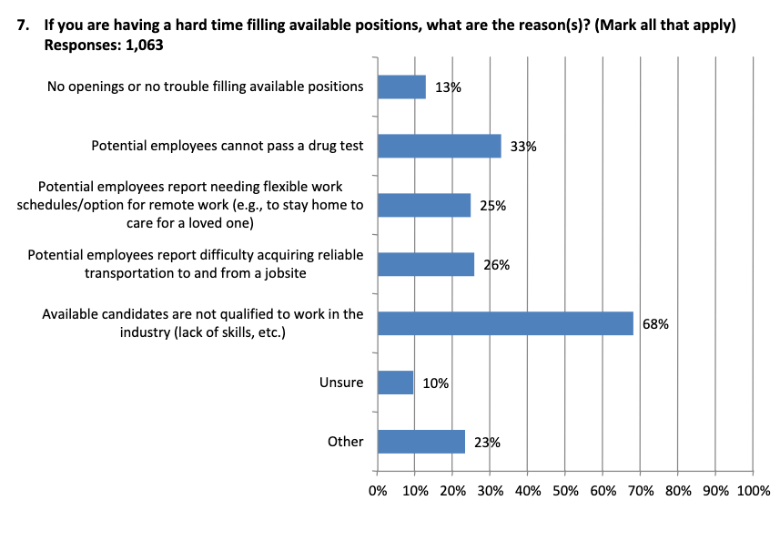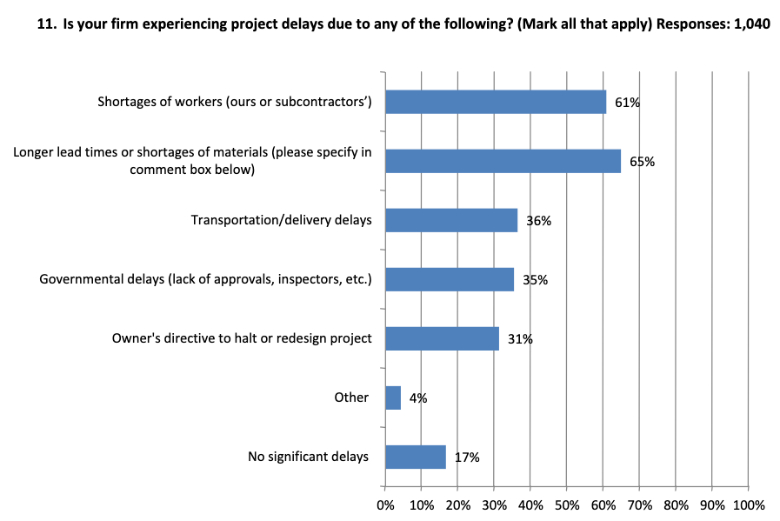A shortage of skilled construction workers is continuing to hamper contractors’ efforts to fill open positions, according to the results of the latest Associated General Contractors of America and Autodesk workforce survey. Ken Simonson, the association’s chief economist, says the results show a need to reconsider how workers are trained nationally.
The results were similar between union and open-shop firms, between small, mid-size and large contractors by annual revenue, across regions and in different segments of construction. Altogether, 85% of about 1,400 contractors that responded to the survey between late July and early August have open craft positions, and 88% of them with open positions reported having a “hard time” filling them. While fewer had salaried positions open, a similar percentage reported difficulty in filling those openings.
The most common issue impacting contractors’ ability to fill open jobs is a lack of qualified candidates, impacting 68% of firms having a hard time filling openings. Simonson called the figure “shocking.”
“These shortages are adding to the impacts of supply chain disruptions that have made it difficult for firms to get materials delivered on time and that are driving up the cost of those materials,” Simonson said during a Sept. 6 webinar on the survey results.
 Graph courtesy of AGC
Graph courtesy of AGC61% of responding firms say that they have experienced project delays because either they or their subcontractors were experiencing worker shortages.
Kenna Smith, talent acquisition manager for Roanoke, Va.-based contractor Branch Group, said that the company has had about 100 open positions every month for the past 18 months or so, and closer to 150 openings in the past six months. She pointed to a shortage of qualified applicants, even for roles such as project engineers, equipment operators and trade workers that would have been easy to fill in the past.
“Over the last couple of years, what we could have considered typically not hard to fill positions are hard to fill,” Smith said.
Hal Fuglevand of contractor and material supplier Knife River’s Billings, Mont., office, says the company’s managers are “desperate” for truck drivers, equipment operators and concrete workers.
“It’s like a revolving door,” he said. “People just won’t show up. You’ve got a concrete pour scheduled in the morning, you’re going to need 10 guys to handle it. Well, three guys just don’t show up.”
 Graph courtesy of AGC
Graph courtesy of AGCA third of contractors responding to the AGC survey also reported that potential employees being unable to pass a drug test was making it hard to fill open positions. Fuglevand noted that marijuana is legal for adults in Montana, but available tests only show whether a person has used marijuana within the past couple of weeks, not whether they are impaired at work.
“I don’t know if we would care that somebody smoked marijuana last weekend, all we care about is, are they in the proper frame of mind to do their work? That could help substantially,” he said.
Rethinking Workforce Training
Contractors’ difficulty hiring shows the need to rethink how people are prepared for the workforce, according to Simonson. AGC has repeatedly called for public officials to add funding for programs to help more students join the construction industry. Simonson said federal officials should encourage more students to get into construction by boosting funding for the Perkins Act, which appropriates federal money for vocational education programs, and by amending who can qualify for programs like Pell Grants, which provide money to undergraduate students.
"We also need to appreciate that it took decades to dismantle our once robust vocational education programs and it will take years to rebuild them,” Simonson said.
He added that federal lawmakers should allow more people with construction skills to legally enter the country and work in the meantime.
“And since the only people who benefit from having a large pool of undocumented workers in the country are those who are willing to exploit them, we also need a path to legal status for people who are already here,” he said.
Simonson said more firms have been turning online to recruit employees via social media or targeted digital advertising. They’ve also been spending more on internal training programs to address skill shortages, and offered more money. 81% of responding contractors say they increased base pay rates and 44% say they have provided incentives or bonuses.
Autodesk Director of Customer Experience and Industry Advocacy Allison Scott said burgeoning uses of artificial intelligence and jobsite robotics can help with the labor shortage but those efforts to use technology are just beginning to have an effect on construction and "it took building information modeling 20 to 30 years to become a standard."
Bill Ryan, workforce development and education coordinator for Montana-based Dick Anderson Construction, said he has found some success with apprenticeships. The company’s four-year apprenticeship program has improved its retention rate from about 20% up to 75% or 80%, he said. Workers who complete the four-year program rise in the company into leadership positions more quickly than other employees. The key is figuring out how to draw and keep younger workers, he adds.
“We have to find the right pieces and put them in the right places to motivate and find out what the motivations are for the younger generation,” Ryan says.





